List of Underground Railroad sites facts for kids
The Underground Railroad was a secret network of safe houses and routes. It helped enslaved people in the 1800s find freedom in North America. This happened before and during the American Civil War. Many brave people, called abolitionists, worked together to end slavery. This list shares important places linked to the Underground Railroad. These sites offered safety, help, and ways for people to travel to freedom.
Contents
- Freedom Routes to Canada
- Underground Railroad Sites in the United States
- Colorado: A Businessman's Fight for Rights
- Connecticut: Helping the Amistad Africans
- Delaware: Quaker Help and Daring Escapes
- District of Columbia: Key Figures and Events
- Florida: Forts of Freedom
- Georgia: Churches and Escape Routes
- Illinois: Midwestern Pathways to Liberty
- Indiana: Homes and Colleges of Freedom
- Iowa: Western Routes to Liberty
- Kansas: John Brown's Legacy
- Maine: Northernmost Sanctuaries
- Maryland: Harriet Tubman's Homeland
- Massachusetts: Abolitionist Strongholds
- Michigan: Crossing the Border to Canada
- Nebraska: A Cabin of Hope
- New Jersey: Secret Routes and Safe Homes
- New York: Busy Ports and Abolitionist Towns
- North Carolina: Southern Escape Routes
- Ohio: The Gateway to Freedom
- Pennsylvania: Quaker and Abolitionist Centers
- Rhode Island: A Haven in New England
- Tennessee: Southern Stations of Escape
- Texas: Paths to Mexico
- Vermont: A Green Mountain Refuge
- Virgin Islands: Freedom in the Caribbean
- Virginia: Historic Escape Routes
- West Virginia: Harpers Ferry and Beyond
- Wisconsin: The First Freedom Seekers
Freedom Routes to Canada
Canada was a major destination for people seeking freedom. In 1793, a law in Canada said that any enslaved person who arrived there would become free. This led to many secret routes from the United States into what was then called Upper and Lower Canada.
Ontario: A Safe Haven
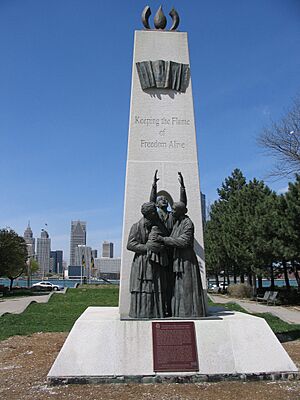
Many people found freedom in Ontario. Here are some key places:
- Amherstburg Freedom Museum – Amherstburg. This museum tells the story of how Africans were forced into slavery. It also shows how they bravely made their way to Canada to find freedom.
- Fort Malden – Amherstburg. One way to reach Ontario was to cross Lake Erie from Ohio to Fort Malden. Another route was across the Detroit River. Many people who escaped slavery lived in this area.
- Buxton National Historic Site and Elgin settlement – Chatham. A minister named Reverend William King started the Elgin settlement in 1849. He freed 15 enslaved people he had inherited. He wanted Buxton to be a safe place for all who escaped slavery.
- Uncle Tom's Cabin Historic Site and Dawn Settlement – Dresden. Reverend Josiah Henson was a former enslaved man. He escaped slavery with his family using the Underground Railroad. In 1841, he helped start the Dawn Settlement. This community offered education and skills to black refugees. They grew tobacco and grain, and sold lumber.
- John R. Park Homestead Conservation Area – Essex. This homestead was a stop on the Underground Railroad.
- John Freeman Walls Historic Site – Lakeshore. John Freeman Walls escaped slavery in North Carolina and settled in Canada. He built a cabin that was a final stop on the Underground Railroad. Church services were held there. Walls and his family stayed in Canada after the American Civil War.
- Queen's Bush – Mapleton. Starting in 1820, African American pioneers settled in this area. More than 1,500 black families created farms and communities. They built churches and schools, taught by American missionaries.
- St. Catharines – Harriet Tubman lived here for ten years. She attended the Salem Chapel. After freeing herself, she helped many others reach freedom in Canada. This town was a final stop for many on the Underground Railroad.
- Sandwich First Baptist Church – Windsor. Black people who came to Canada for freedom built this church. It was a sanctuary for those escaping slavery. In 1999, it became a National Historic Site.
Nova Scotia: Early Black Settlements
African-American people have lived in Nova Scotia since 1749.
- Birchtown National Historic Site – Birchtown. This was a settlement for black people from Colonial America. They gained freedom by serving the British during the American Revolutionary War. Birchtown was the largest free black community in British North America in the late 1700s.
- Africville – Halifax. Black people settled in Africville starting in 1848. They built a community with a Baptist church, a school, and stores.
Underground Railroad Sites in the United States
Colorado: A Businessman's Fight for Rights
- Barney L. Ford Building — Denver. Barney Ford was an escaped enslaved person who became a very successful businessman. He fought for black voting rights in Colorado. He used the Underground Railroad to escape and helped others.
Connecticut: Helping the Amistad Africans
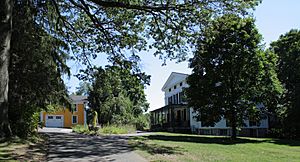
- Austin F. Williams Carriagehouse and House — Farmington. This property was important in the famous Amistad case. It was also a station on the Underground Railroad.
- First Church of Christ, Congregational — Farmington. This church was a center for the Underground Railroad. It also helped the African people who revolted on the Spanish ship La Amistad. When these Africans were freed in 1841, they came to Farmington.
- Polly and William Wakeman House — Wilton. The Wakemans were abolitionists who helped people escaping slavery. Their house had a secret tunnel. They would take people on late-night trips to nearby towns on the Underground Railroad.
Delaware: Quaker Help and Daring Escapes
- Camden Friends Meetinghouse — Camden. This Quaker meeting house was built in 1806. Many of its members, like John Hunn, were active in the Underground Railroad.
- Tilly Escape site — Seaford. This site marks a daring route used by Harriet Tubman to help people escape slavery.
- Friends Meeting House — Wilmington.
District of Columbia: Key Figures and Events
- Frederick Douglass National Historic Site. This was the home of Frederick Douglass, a famous abolitionist and writer who escaped slavery.
- Mary Ann Shadd Cary House. Mary Ann Shadd Cary was an important black activist, teacher, and newspaper publisher.
- Pearl incident at 7th Street Dock. This was a famous attempt by 77 enslaved people to escape to freedom by boat in 1848.
Florida: Forts of Freedom
- Negro Fort — near Sumatra. This fort was a refuge for escaped enslaved people and Native Americans.
- Fort Mosé — St. John's County. This was the first free black settlement in what is now the United States. It was established by the Spanish in 1738 for people escaping British slavery.
Georgia: Churches and Escape Routes
- First African Baptist Church — Savannah. This historic church played a role in the Underground Railroad.
- Dr. Robert Collins House - William and Ellen Craft Escape Site — Macon. This site is linked to the daring escape of William and Ellen Craft, who disguised themselves to travel north.
Illinois: Midwestern Pathways to Liberty
- Old Rock House — Alton.
- New Philadelphia Town Site — Barry. This was the first town in the United States founded by an African American. It was a stop on the Underground Railroad.
- Quinn Chapel AME Church — Brooklyn.
- Graue Mill — Oak Brook. This mill was a known station on the Underground Railroad.
- Owen Lovejoy House — Princeton. Owen Lovejoy was a famous abolitionist and politician. His home was a key stop on the Underground Railroad.
- John Hossack House — Ottawa. John Hossack was an abolitionist who helped many people escape slavery.
- Dr. Richard Eells House — Quincy. Dr. Eells was arrested for helping an enslaved person escape.
Indiana: Homes and Colleges of Freedom

- Levi Coffin House — Fountain City. Levi Coffin was known as the "President of the Underground Railroad." He and his wife, Catharine, helped over 2,000 people escape slavery.
- Bethel AME Church — Indianapolis. This church was a safe place for many freedom seekers.
- Eleutherian College Classroom and Chapel Building — Lancaster. This college was founded on anti-slavery principles. It welcomed all students, regardless of race or gender.
- Town Clock Church (now Second Baptist Church) — New Albany. This church was a significant stop on the Underground Railroad.
Iowa: Western Routes to Liberty
- Reverend George B. Hitchcock House — Lewis vicinity. This house was a station on the Underground Railroad.
- Henderson Lewelling House — Salem. Lewelling was a Quaker who helped many people escape slavery.
- Jordan House — West Des Moines. This house was a known stop on the Underground Railroad.
Kansas: John Brown's Legacy
- Fort Scott National Historic Site — Bourbon County.
- John Brown Cabin — Osawatomie. This cabin belonged to John Brown, a famous abolitionist who fought against slavery.
Maine: Northernmost Sanctuaries
- Harriet Beecher Stowe House — Brunswick. Harriet Beecher Stowe wrote the famous anti-slavery novel Uncle Tom's Cabin while living here.
- Abyssinian Meeting House — Portland. This was an important meeting place for the black community and abolitionists.
Maryland: Harriet Tubman's Homeland
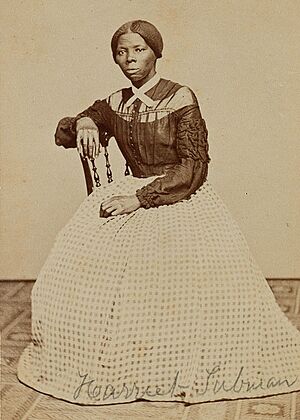
- President Street Station — Baltimore. This train station was a gateway for many people escaping slavery to travel north.
- Harriet Tubman's birthplace — Dorchester County. This area is where Harriet Tubman was born into slavery. She later became a famous "conductor" on the Underground Railroad, leading many to freedom.
- John Brown's Headquarters — Sample's Manor. This farm was where John Brown planned his raid on Harpers Ferry.
Massachusetts: Abolitionist Strongholds
- African American National Historic Site — Boston. This site includes many places important to Boston's black community and the abolitionist movement.
- William Lloyd Garrison House — Boston. William Lloyd Garrison was a leading abolitionist and publisher of the anti-slavery newspaper The Liberator.
- Black Heritage Trail, including the Lewis and Harriet Hayden House — Boston. This trail highlights the history of Boston's 19th-century African American community. The Hayden House was a safe house on the Underground Railroad.
- Nathan and Mary Johnson House — New Bedford. This was the first safe house for Frederick Douglass after he escaped slavery.
Michigan: Crossing the Border to Canada
- Guy Beckley — Ann Arbor. Guy Beckley was an Underground Railroad conductor and speaker against slavery. His house is recognized as a Network to Freedom site.
- Second Baptist Church — Detroit. This church was a major stop on the Underground Railroad, helping many people cross into Canada.
- Dr. Nathan M. Thomas House — Schoolcraft. Dr. Thomas was a Quaker doctor who helped over 1,000 people escape slavery.
- Wright Modlin — Williamsville, Cass County. Wright Modlin's house was a station. He often traveled south to help people escape slavery and bring them to Cass County. His success angered slaveholders, leading to the Kentucky raid on Cass County in 1847.
Nebraska: A Cabin of Hope
- Mayhew Cabin — Nebraska City. This cabin was a significant stop on the Underground Railroad in the Midwest.
New Jersey: Secret Routes and Safe Homes

- Mott House — Lawnside Borough. Peter Mott was a free black man and a conductor on the Underground Railroad. His house was a safe haven.
- Grimes Homestead — Mountain Lakes.
- Bethel AME Church — Springtown. This church played a role in helping freedom seekers.
New York: Busy Ports and Abolitionist Towns
- Stephen and Harriet Myers House — Albany. Stephen and Harriet Myers were important black abolitionists. Their home was a key station on the Underground Railroad.
- Harriet Tubman House and Thompson AME Zion Church — Auburn. This site honors Harriet Tubman's life and work after she settled in Auburn.
- North Star Underground Railroad Museum — Ausable Chasm. This museum tells the story of the Underground Railroad in northern New York.
- Michigan Street Baptist Church — Buffalo. This church was a major stop for people heading to Canada.
- St. James AME Zion Church — Ithaca.
- John Brown Farm State Historic Site — Lake Placid. This was the home and burial place of abolitionist John Brown.
- Abolitionist Place — New York City: Brooklyn. This street was a center for anti-slavery activity. Many freedom seekers arrived in Brooklyn by ship, hidden among cargo. Conductors helped them find shelter, clothing, and food.
- Plymouth Church of the Pilgrims — New York City: Brooklyn. This church was known for its strong anti-slavery stance and helped many on the Underground Railroad.
- Niagara Falls Underground Railroad Heritage Center — Niagara Falls. This center tells the stories of those who crossed into Canada at Niagara Falls.
- Gerrit Smith Estate and Land Office — Peterboro. Gerrit Smith was a wealthy abolitionist who provided land and support to many freedom seekers.
- Smithfield Community Center — Peterboro. This building, formerly a church, held the first meeting of the New York Anti-Slavery Society.
North Carolina: Southern Escape Routes
- Guilford College Woods meeting place, Guilford College — Greensboro. This Quaker college had a strong anti-slavery history.
- Freedmen's Colony of Roanoke Island Network to Freedom site — Manteo, Outer Banks. This was a colony for formerly enslaved people during the Civil War.
Ohio: The Gateway to Freedom
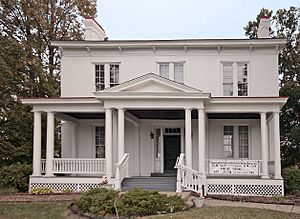
- Harriet Beecher Stowe House — Cincinnati. Harriet Beecher Stowe lived here. Her experiences and observations in Ohio influenced her famous book, Uncle Tom's Cabin.
- James and Sophia Clemens Farmstead — Greenville.
- Mount Pleasant Historic District — Mt. Pleasant. This town was a hub of abolitionist activity.
- Wilson Bruce Evans House — Oberlin. Wilson Bruce Evans was a free black man who helped many freedom seekers. Oberlin College was also a strong anti-slavery center.
- John P. Parker House — Ripley. John P. Parker was a formerly enslaved man who bought his freedom. He became a daring conductor on the Underground Railroad, helping hundreds cross the Ohio River.
- John Rankin House — Ripley. Reverend John Rankin was a famous abolitionist. His house, high on a bluff overlooking the Ohio River, was a beacon for freedom seekers.
Pennsylvania: Quaker and Abolitionist Centers
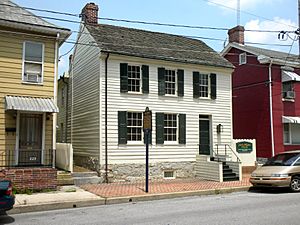
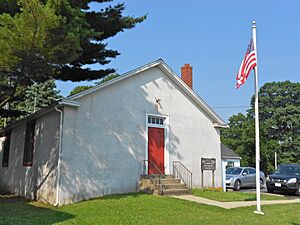
- John Brown House — Chambersburg.
- Dobbin House — Gettysburg. This historic tavern had secret hiding places for freedom seekers.
- Thaddeus Stevens Home and Law Office – Lancaster. Thaddeus Stevens was a powerful abolitionist politician.
- Johnson House — Philadelphia. This house was a key station on the Underground Railroad, run by a Quaker family.
- Liberty Bell, Independence National Historical Park — Philadelphia. The Liberty Bell became a symbol of the abolitionist movement.
- Hovenden House, Barn and Abolition Hall — Plymouth Meeting. This site includes a house, barn, and a hall where abolitionist meetings were held.
- F. Julius LeMoyne House — Washington. Dr. LeMoyne was a strong abolitionist.
Rhode Island: A Haven in New England
- Isaac Rice Homestead — Newport.
Tennessee: Southern Stations of Escape
- Burkle Estate (Slavehaven) — Memphis. This house is believed to have been a station on the Underground Railroad. It is now a museum.
Texas: Paths to Mexico
- Matilda and Nathaniel Jackson. The Jacksons were free black landowners who helped people escape slavery towards Mexico.
- Silvia and John Webber. The Webbers were also free black landowners who helped freedom seekers.
Vermont: A Green Mountain Refuge
- Rowland E. Robinson House, Rokeby — Ferrisburgh. This Quaker farm was a safe house on the Underground Railroad.
Virgin Islands: Freedom in the Caribbean
- Annaberg Sugar Plantation and School — St. John. This site shows the history of slavery in the Caribbean.
Virginia: Historic Escape Routes
- Bruin's Slave Jail — Alexandria. This was a notorious slave jail, but it also represents the desire for freedom.
- Fort Monroe — Hampton. During the Civil War, this Union-controlled fort became a "Freedom's Fortress" for enslaved people who escaped to Union lines.
West Virginia: Harpers Ferry and Beyond
- Harpers Ferry National Historical Park — Harpers Ferry. This town was the site of John Brown's famous raid, which aimed to start a slave rebellion.
Wisconsin: The First Freedom Seekers
- Milton House — Milton. This inn has a secret tunnel that was used to hide freedom seekers.
- Joshua Glover — Milwaukee. Joshua Glover was an escaped enslaved person whose capture led to a famous protest and rescue.
- Lyman Goodnow — Waukesha. Lyman Goodnow was a conductor who helped Caroline Quarlls, the first known freedom seeker on Wisconsin's Underground Railroad, reach Canada.
|



